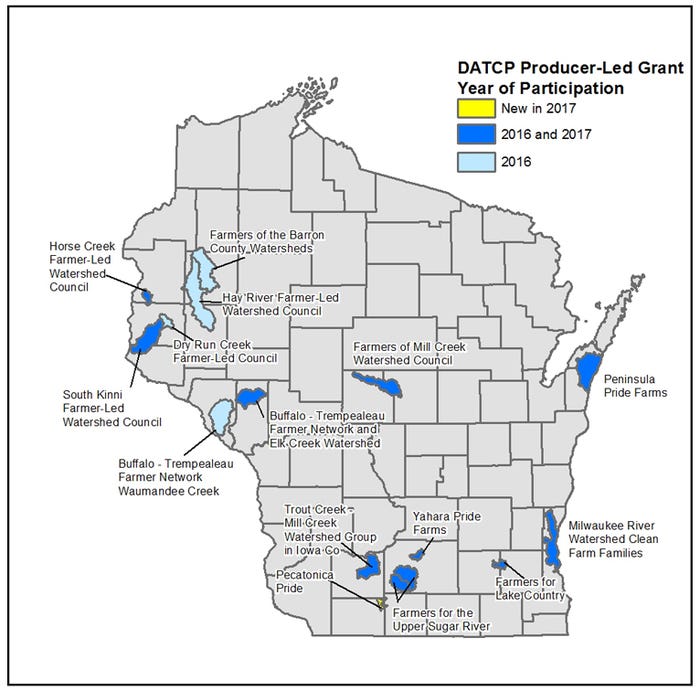February 16, 2017

Over the last few years, numerous farmers have come together to improve water quality in their own backyards, so to speak. To aid in this effort, in 2016 the Wisconsin Department of Agriculture, Trade and Consumer Protection offered grants to give financial support to farmers willing to lead conservation efforts in their watersheds. Funds for this program were included in 2015-17 Wisconsin state budget, with grants not to exceed $20,000 per watershed group.
Supporting grants
Grants went to projects that focus on ways to prevent and reduce runoff from farm fields, and to support work to increase farm participation in these voluntary efforts. Fourteen producer-led groups received funding in 2016 for a total of $242,500, and 11 producer-led groups were awarded $197,000 for 2017 (see map below). Groups are collaborating with one or more of the following: University of Wisconsin Extension, county land and water conservation departments, UW Discovery Farms, Michael Fields Agricultural Institute, and local nonprofit conservation organizations.

Farm organizations such as Wisconsin Farm Bureau, Wisconsin Farmers Union and Wisconsin Soybean Association, to mention a few, support these great producer-led efforts. Wisconsin Farm Bureau, for example, has adopted policy that states, “We support farmer-led soil and water quality initiatives,” and encourages county Farm Bureaus to support these groups because they represent local efforts by the people who live in the area.
What are these farmer groups doing to improve water quality? Each group designed its own approach to this issue. Many groups are offering incentives for planting cover crops, doing minimum-till and no-till planting, and experimenting with low-disturbance manure-injection systems. Some are focusing on soil testing, phosphorus indexing and nutrient management planning. Others are assessing their farms through farm walkovers, identifying conservation needs or measuring reductions in field runoff from installed conservation practices using edge-of-field flow monitors.
Several on-farm research trials are being conducted, including looking at cover crop effects on soil moisture and soil temperature leading up to spring planting, and studying the effectiveness of using agri-drain tile line controls to manage nutrient losses from tile-drained fields.
Additional efforts focus on outreach and education through field days and workshops. These include education for both farmers and the general public on conservation practices and conservation efforts. They also serve as a tool to encourage additional participation from area farmers.
An example
I work with the Farmers of Mill Creek Watershed Council to improve water quality of the Mill Creek, which flows from Marshfield to Stevens Point, spanning Wood and Portage counties. The Farmers of Mill Creek Watershed Council is working to reduce phosphorus loading of Mill Creek from nonpoint sources (farm fields and barnyards, to be specific). The intent is to further educate themselves and their neighbors on phosphorus best management practices.
Goals for the Farmers of Mill Creek watershed project include:
• Further educate farmers and their neighbors on phosphorus best management practices with the goal of improving water quality of Mill Creek in Portage and Wood counties.
• Focus on adopting more environmentally friendly farming practices that will ensure clean water and healthy soils for future generations while maintaining or improving profitability.
• Be stewards of environmental sustainability for the land and water in the watershed.
• Demonstrate to the public that farmers are conservation leaders who care about their land and water and are doing everything they can to care for it.
Accomplishments
In 2016, the members of the Farmers of Mill Creek Watershed Council used or installed various conservation practices on their farms, such as no-till planting, cover crop planting, cover crop variety demonstration plots or waterway buffer strips. They hosted an on-farm research project site looking at cover crop effects on soil temperature and soil moisture. These conservation practices covered more than 750 acres.
Three field days throughout the year attracted about 150 area farmers and local residents to learn about conservation practices that will ensure clean water and healthy soils for future generations while maintaining or improving farm profitability. About $18,900 in cost-share funds were provided to farmers as part of this project, with $8,600 provided by a Wisconsin DATCP Producer-Led Watershed Protection Grant and $10,300 in additional support from county land and water conservation funds.
Farmers are resilient and, by nature, are problem-solvers who are willing to address issues head-on.
More information about the DATCP Producer-Led Watershed Protection Projects and grant funding opportunities is available online.
Schroeder is the Portage County Extension agricultural agent.
About the Author(s)
You May Also Like




